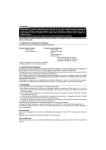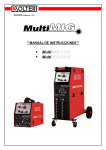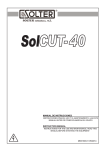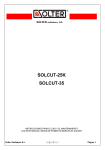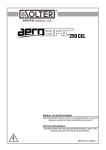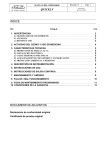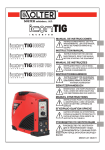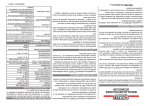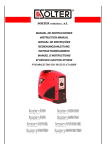Download Manual instrucción
Transcript
PANEL FRONTAL / FRONT PANEL MANUAL DE INSTRUCCIONES INSTRUCCIONES PARA EL USO Y EL MANTENIMIENTO, LEA ESTE MANUAL ANTES DE PONER EN MARCHA EL EQUIPO INSTRUCTION MANUAL INSTRUCTIONS FOR THE USE AND MAINTENANCE, READ THIS MANUAL BEFORE STARTING THE EQUIPMENT MI03031-03 07/2012 INDICE INDICE..............................................................................................................1 INTRODUCCIÓN ..............................................................................................2 PANEL DE MANDOS........................................................................................2 AJUSTES E INDICADORES ............................................................................3 POSIBLES ANOMALÍAS Y DEFECTOS ..........................................................4 DECLARACIÓN DE CONFORMIDAD..............................................................A1 CERTIFICADO DE GARANTÍA ........................................................................A1 SOLTER SOLDADURA S.L. 1 INTRODUCCIÓN Agradecemos su deferencia hacia nuestra marca y esperamos le sea de gran utilidad el equipo de soldadura que acaba de adquirir. El presente manual de instrucciones contiene las advertencias necesarias para una correcta utilización dentro de las máximas condiciones de seguridad para el operario. Los equipos de soldadura SOLTER deben ser empleados por personal experto que conozca y comprenda los riesgos involucrados en la utilización de los mismos. En caso de incomprensión o duda sobre este manual les rogamos que se ponga en contacto con nosotros. La manipulación del equipo de soldadura conlleva un peligro importante de lesión. Rogamos se abstenga de efectuar cualquier manipulación en el mismo. Sólo personal técnicamente preparado puede realizarlo. SOLTER Soldadura, S.L. declina toda responsbilidad por practicas negligentes en la utilización y/o manipulación. En este manual debe adjuntarse y conservarse con el equipo adquirido. Es responsabilidad de las personas que los utilicen y reparen que el producto no deje de cumplir los requisitos de las normas mencionadas. PANEL DE MANDOS Partes del panel de mandos 1-Interruptor ON/OFF 2-Selector diámetro de hilo 3-Selector modo de soldadura 4-Enhebrado de hilo manual 5-Regulación velocidad de hilo/Offset 6-Indicador modo manual activado 7-Indicador modo sinérgico activado 8-Regulación tiempo spot 9-Selección modo sinérgico/manual 10-Indicadores de anomalías 11-Selector de material Figura 1 Selector modo de soldadura Selecciona entre los diferentes modos de trabajo, a cada pulsación cambia al modo siguiente. Posibles modos: 2T 4T 2T con SPOT (soldadura de puntos) Selección modo sinérgico/manual Con el pulsador 9 (Figura 1) podemos elegir entre el modo manual, indicador verde iluminado, y el modo sinérgico, en este caso se iluminarán los indicadores de material y diámetro usando las teclas 2 y 11 (Figura 1). Enhebrado de hilo manual Usando la tecla 4 (Figura 1) podemos realizar el enhebrado manual del alambre, la velocidad del enhebrado la controlaremos con el regulador nº5 (Figura1). SOLTER SOLDADURA S.L. 2 Ajuste SPOT Si tenemos activado el modo SPOT podremos ajustar el tiempo del punto de soladura entre 0,1segundos y 5 segundos (Regulador 8 figura 1).Debemos mantener el pulsador de la antorcha accionado y el equipo parará la alimentación del hilo y la poténcia automáticamente al final del tiempo. AJUSTES E INDICADORES Indicadores del panel frontal (10 figura 1) -Indicador A: Indicador de anomalía. Indica una anomalía interna del equipo, puede iluminarse esporádicamente durante el funcionamiento del equipo sin afectar al funcionamiento de este. En caso de permanecer iluminado avisar al servició técnico. -Indicador B: Indica el sobrecalentamiento del equipo. Dejar enfriar el equipo durante unos minutos. -Indicador C: Indicador de anomalía en el refrigerador (depende del equipo). Indica un mal funcionamiento del refrigerador, debido a la falta de líquido refrigerante en el circuito o por que este está obstruido. En el caso de iniciar el cebado de la bomba puede iluminarse, en este caso parar el refrigerador con el interruptor situado en la potencia y volver a ponerlo en marcha. Puede que tenga que repetir la operación varias veces, hasta conseguir el cebado de la bomba. -Indicador D: Indica que el equipo está suministrando potencia, debe lucir siempre que tengamos el pulsador de la antorcha apretado. Modo manual El equipo permite ajustar la velocidad del motor desde el mínimo unos 2m/min (depende del modelo) al máximo (depende del modelo). En este modo se deberá ajustar la velocidad con el ajuste 5 (figura 1), para adecuarla a la potencia que tengamos seleccionada. Modo sinérgico Este modo de trabajo proporciona un ajuste automático de la velocidad del alimentador dependiendo del material y la potencia ajustada. En este caso el ajuste (5 Figura 1) varía la velocidad en un +/10%, para hacer pequeños ajustes en el arco. En la posición +10% tendremos un arco muy corto y en la posición -10% tendremos un arco con tendencia a globular. Se recomienda siempre ajustarlo a laposición 0%. Ajuste del modo sinérgico Dos posibilidades de selección, el primer selector nos permite ajustar el diámetro del alambre que utilizamos, el segundo nos permite escoger el material. Para una óptima operación del modo sinérgico se debe elegir correctamente el material y el diámetro del alambre. Si seleccionamos el modo manual se apagaran todos los indicadores, recuperando su estado inicial al volver a activar el modo sinérgico. Los pilotos indicadores de material pueden encenderse en intermitencia, esto nos indica que estamos fuera de la capacidad de ajuste para la potencia seleccionada. SOLTER SOLDADURA S.L. 3 Ajuste Burn-back Ajusta la longitud del alambre que quedará al finalizar la soldadura. Para materiales tipo acero o acero inoxidable ajustar un tiempo largo. En materiales blandos como el aluminio debe ajustarse un tiempo corto. Ajuste arranque (Slope up) Con este ajuste determinamos la suavidad de la arrancada. En modo manual ajustará la rampa de aceleración del alambre y debe ajustarse correctamente para cada material y potencia. En modo sinérgico ajusta la velocidad inicial del alambre, se deberá ajustar dependiendo del diámetro de este. El arranque del arco va controlado por el contacto de este con la pieza, no se iniciará la aceleración del alambre si no hay un contacto con la pieza a soldar. Tanto el ajuste de Burn Back como el de Slope up están situados en la parte interna del panel frontal, accediendo a ellos desde el alojamiento de el alambre de soldadura. POSIBLES ANOMALÍAS Y SOLUCIONES Anomalía En modo sinérgico. El arco es muy alto. En modo sinérgico. El arco es muy corto y impacta sobre la pieza. El alambre da bandazos y parece no tener una velocidad estable El indicador de material parpadea SOLTER SOLDADURA S.L. Causa Poca velocidad de alambre Mucha velocidad de alambre El consumible de la antorcha no es el adecuado o está desgastado. La guía del alambre de la antorcha no es la adecuada o está en mal estado La tensión del arrastre no es la correcta Tenemos seleccionada una potencia superior a la capacidad de suministro de alambre del equipo Solución Verificar que tenemos seleccionado el material i el diámetro adecuados Verificar que tenemos seleccionado el material i el diámetro adecuados Cambiar el consumible Verificar la guía y sustituirla si procede Verificar y ajustar la tensión Reducir la potencia del equipo. Cambiar a un alambre de diámetro superior 4 INDEX INDEX ..............................................................................................................5 INTRODUCTION ..............................................................................................6 CONTROL PANEL ............................................................................................6 ADJUSTMENTS AND LED INDICATORS ........................................................7 TROUBLESHOOTING......................................................................................8 DECLARATION OF CONFORMITY ................................................................A1 WARRANTY CERTIFICATE ............................................................................A1 SOLTER SOLDADURA S.L. 5 INTRODUCTION Thank you for selecting one of our products. We are sure you will find this unit very useful. . These instructions contain the necessary information and security warnings to enable the correct use of the unit under the safest conditions for the operator. In order to obtain the maximum performance of this unit, we suggest you read the instructions carefully. If in any doubt regarding any aspect of the instructions, please contact us for guidance. Operation of this equipment involves serious risk of electric shock. Do not touch the live parts or the internal parts of the unit. Only qualified personnel are authorised to do so. SOLTER SOLDADURA, S.L. will in no way be held liable for any damage caused by the improper use or operation of this unit. These instructions are provided together with the unit you have purchased and must be kept for future reference. It is the sole responsibility of the user or of the personnel who repair this unit to guarantee that it keeps complying with all the relevant local or state safety requirements. CONTROL PANEL Parts 1-ON/OFF Switch 2-Wire Diameter Selector 3-Welding Mode Selector 4-Manual Wire Threading 5-Wire-feed Speed Control / Offset 6-Manual Welding Mode Indicator active 7-Synergic Welding Mode Indicator Active 8-Time Adaptive Spot- Welding Control 9-Synergic / Manual Mode Selection 10-Anomalies Indicators 11-Material Selection Figure 1 Welding Mode Selector Switch This switch enables choosing between different working modes. Press the selector to switch from one mode to another. Welding Modes allowed: 2T 4T 2T SPOT mode (spot-welding) Synergic / Manual Mode Selection Switch number 9 (Fig. 1) enables choosing between Manual Mode – the green LED illuminates – and Synergic Mode. When switched to this latter mode wire diameter and base material LEDs illuminate (keys 2 and 11, fig. 1). Manual Wire Threading Switch number 4 (fig. 1) enables threading the wire manually. Wire-feed speed can be adjusted through knob number 5 (Fig.1) SOLTER SOLDADURA S.L. 6 SPOT-welding Adjustment When the unit is set on SPOT-welding mode, spot-welding time can be adjusted between 0.1 and 5 seconds (knob 8, fig. 1). Press and hold the torch trigger and it will stop automatically after the pre-selected time. ADJUSTMENTS AND LED INDICATORS Front Panel Indicators (10 figure 1) LED A: It lights to indicate that the unit suffers an internal anomaly. It may illuminate now and then while the unit is running without affecting the results. If the LED remains lit, contact your technical service. -LED B: It lights to indicate overheating. If this LED illuminates you must let the unit cool down for some minutes. -LED C: It lights to indicate there is a malfunction in the cooling system (depending on the equipment). This could be caused by a lack of refrigerant in the circuit or because the circuit is blocked. It may also illuminate when you proceed to prime the pump. In this case stop the cooling-system by turning off the power switch and then turn it on again. You may need to repeat this operation several times before the pump is primed. - LED D: It lights to indicate that the equipment is supplying power. It must always be lit if you are pressing the torch trigger Manual Mode This mode allows setting the welding speed manually from a minimum of 2m/ min to the maximum (this range depends on the model). If you select this mode, set the speed using knob 5 (fig. 1) in order to adjust it to the pre-selected voltage. Synergic Mode This mode offers the automatic adjustment of the wire-feed speed according to material used and pre- selected voltage. In this mode the automatic speed value (5, fig. 1) can be adjusted within the range of +/- 10% in order to make small adjustments to the arc. The + 10% position gives a very short arc whereas the -10% position gives an arc that tends to be globular. The optimum value is position 0%. Synergic Mode Setting This mode has two knobs. The first knob enables to adjust the diameter of the wire being used; the second allows selecting the base material. In order to maximise the operating efficiency of the unit material used and wire’s diameter selectors must be properly adjusted when working in this mode. If you select the manual mode, all LED lights will turn off. The unit will go back to its initial state when you activate the synergic mode again. If the “material used” LED is flashing this indicates you have exceeded the parameters that are suitable to work with the pre-selected voltage. SOLTER SOLDADURA S.L. 7 Burn-back Time Adjustment This function allows setting a time delay between the arc stopping and the wire-feeding. Materials such as steel or stainless steel require a long burn-back time whereas soft materials such as Aluminium need a short burn-back time. Slope-Up Adjustment It allows you to determine how smooth you want the welding to start. When working in manual mode you must properly adjust acceleration time depending on material used and voltage. In the Synergic Mode the initial wire speed is set according to the wire’s diameter. The arc’s start is controlled by the contact of the arc with the work piece. Acceleration will only take place if there is contact with the work piece. Both the Burn-back and the Slope-Up adjustments are located inside the front panel. You may access them through the welding wire compartment. POSSIBLE PROBLEMS AND SOLUTIONS Problem Welding in Synergic Mode the arc length is too long Welding in Synergic Mode the arc length is too short and impacts on the work piece Wire feeds erratically at an unsteady speed Possible Cause Low wire feeding speed Excessive wire feeding speed Incorrect or worn out contact tip Incorrect or worn out torch wire guide Incorrect tension on drive rolls The selected voltage exceeds The “material” indicator LED is the unit’s wire-feeding capaflashing city. SOLTER SOLDADURA S.L. Solution Check you have set correctly the “material used” and “wire diameter” parameters Check that you have set correctly the “material used” and “wire diameter” parameters Replace contact tip Check wire guide and replace if necessary Check and adjust drive tension Check for the correct voltage. Change to larger diameter wire 8 SOLTER SOLDADURA S.L. A9











